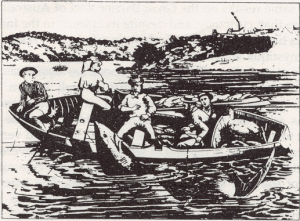It is quite possibly the most frequently asked question by visitors traveling out to the Great Barrier Reef: “Am I going to see a shark?” This question is asked a couple of different ways. Some people pose this question wide eyed with anxiety and their voices faltering; others, with an excited heartbeat and a hopeful tone. Sharks have a special, mythical place in the human psyche. Most associate the word “shark” with the two-tone theme song to the movie “Jaws” But sharks have, for decades, been the victims of bad publicity, and the relationship between sharks and humans has changed widely throughout the years.
Since humans first encountered the ocean, sharks have held a special place in many cultures and traditions. In Hawaiian mythology, there were several main shark gods. It was commonly believed that, when a person died, their family could offer the corpse to become a shark. Indigenous Australians talk about Bangudja, the tiger-shark, which attacked the dolphin man in the Gulf of Carpentaria, leaving behind a large red spot on the rocks of Chasm Island, which can be seen even today. Native Americans in the North-western United States often presented images of the dogfish sharks on their totem posts, in the memory of a woman kidnapped by a shark, turned herself into a shark. In the 18th and 19th century, sharks following a sailing vessel were regarded as a sign of imminent death.
Scientifically, study of sharks first began in earnest in World War II by the United States military. On July 30, 1945, two torpedoes slammed into the USS Indianapolis, which four days earlier had transported the world’s first combat-ready atomic bomb to the American air base at the Pacific island of Tinian. Military personnel left adrift reported numerous attacks by sharks while awaiting rescue – if they were lucky enough to survive. The US Navy at the time provided sailors with a product called “Shark Chaser,” a purplish dye that would confuse sharks when spread out in the water, and that provided some protection for a few hours. Four long days passed before a rescue vessel came. The horror of what rescuers found still shocks today: 579 men dead; while not all were victims of shark bites, after this event research began in earnest to find an effective shark repellent, research that continues to this day.
Currently, the relationship between sharks and humans is at a bit of a crossroads. Shark attacks make for sensational news stories, especially when they prove fatal, yet more people worldwide are killed by coconuts, champagne corks, ladders, icicles, and even vending machines. Humans, on the other hand, kill anywhere from an estimated 70 to 200 million sharks for a variety of reasons, with the most common being the shark fin trade, where sharks are caught and their fins are cut off. After cutting off the fins, the rest of the shark is thrown back into the water, where it sinks to the bottom to die. Other uses for caught shark include meat from some species, teeth and jaws for tourist souvenirs, and cartilage and liver oil for homeopathic medicines. Indeed, with 73 species of shark listed as threatened or endangered, time may be running out to save these ocean predators.
So when you come out to the reef, keep an eye out for these stealthy predators. Take photos, and encourage friends and family to enjoy their presence, rather than fear them. To help out while travelling, avoid jaws and necklaces featuring teeth. At home, spread the word about the plight of sharks worldwide, and avoid buying nutritional supplements made from shark products. Together, we can ensure that the story of the relationship between sharks and humans does not end sadly and prematurely.
Remember: We have one planet; let’s look after it.

